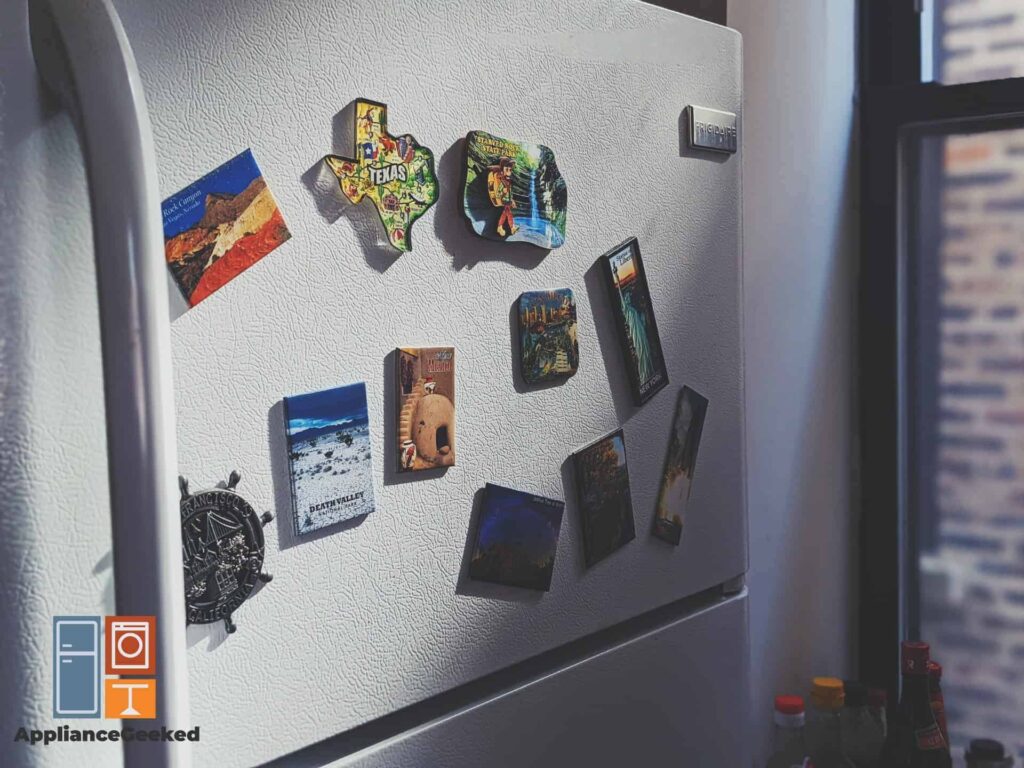Did you know that the average refrigerator will eat up $10 worth of energy every day? But that’s the average fridge, something as modern and advanced as a Samsung fridge will differ.
In this article, we’re looking at how many watts a Samsung refrigerator uses. We’ll also give you a breakdown of how many dollars you’re paying per day.
Additionally, we’re giving six ways you can calculate how much energy your Samsung fridge is consuming!
How much energy does a Samsung fridge use?
A Samsung fridge will typically use up 500 kWh per year. On average, your Samsung fridge will make up only 5% of your energy bill!
Some models also have a built-in energy-saver function that drastically changes the energy consumption per day.
If you want a more detailed breakdown of how much kWh your model uses per year, check out the table below:
| Samsung Model | Energy Consumption Per Year |
| Samsung RB29FSRNDSA | 293kWh |
| Samsung RF261BIAESR | 398kWh |
| Samsung RF27T5201 | 705kWh |
| Samsung RF28T5101 | 645kWh |
| Samsung RF28R7201 | 755kWh |
| Samsung RF28R7551 | 755kWh |
| Samsung RS27T5200SR | 728kWh |
| Samsung RF23A9771 | 631kWh |
| Samsung BRF425200 | 629kWh |
| Samsung RF23J9011 | 680kWh |
| Samsung BESPOKE RF30BB6600 | 695kWh |
| Samsung RT18M6215 | 448kWh |
| Samsung RF260BEAE | 449kWh |
| Samsung RF18A5101 | 540kWh |
| Samsung RF20A5101 | 560kWh |
| Samsung 4-Door Flex RF29A9071 | 705kWh |
| Quick Note: The numbers presented above are the average and expected energy consumption for these models. So it may be higher or lower depending on how much you use your refrigerator. |
How to Calculate the Energy a Samsung Fridge Uses
To calculate the energy your Samsung fridge uses, you can use a power meter. If you don’t have one, you can check either the fridge’s label, BEE Star rating, manual, or the Samsung website.
As mentioned, the numbers above may differ based on a multitude of different factors. As such, it’s easier if you can calculate the energy your Samsung fridge uses yourself.
There are different ways to do so, but here are some of the easiest and most common ones:
Check the Labels

Your Samsung refrigerator should include a label usually found behind the appliance. This should tell you how much wattage is used per hour.
Once you find it, you can then calculate the wattage used per day by doing the math. So if your Samsung fridge uses 100W per hour and you have your fridge turned on the entire day, that’s 2,400W per day.
BEE Star

You can also check the BEE star-rated sticker on your appliance to check the wattage. The sticker should show the annual energy consumption.
If you want to do the math, you can divide the wattage by 12 so you’re aware of the fridge’s monthly wattage use. Furthermore, you can divide the annual wattage by seven or 30/31 to get an idea of the weekly or monthly wattage.
However, don’t rely too heavily on the BEE sticker, as the numbers were drawn from a test. The results from these tests could be different depending on the situation of your fridge and which mode you’re using.
Power Meter
If you want the most accurate way to check your Samsung fridge’s wattage, then we recommend buying a power meter. These power meters will give the exact number as they measure the energy directly.
Once you have your power meter, plug your Samsung refrigerator in and let it run for 24 hours. Afterward, it should display the number on the screen.
This is especially useful if you want to plan an energy-saving scheme. Not only that, but you can also use it with your other appliances to better gauge which ones cost more to use!
Look at the Manual
If you still have the manual that comes with your Samsung fridge, you can get a detailed look at the wattage used! Not only will it show the annual wattage, but it should also list the monthly, weekly, daily, and hourly energy use.
In addition to the wattage, the manual also shows what type of condition compels the refrigerator to use more energy. Knowing such a thing should allow you to avoid these conditions and hopefully save more money!
Check the Official Samsung Website
If you don’t have the manual of your fridge, then don’t fret! Checking the official Samsung website should give you the same information as the fridge manual itself.
Simply go to the Samsung website and look for your fridge’s model. The site should display the annual, monthly, weekly, daily, and hourly wattage rate of your fridge.
Additionally, you can also call the company itself. A neat bonus if you do is you can ask questions that don’t necessarily have answers on Samsung’s website.
Factors Contributing to a Samsung Fridge’s Power Consumption
There are different factors that contribute to your Samsung fridge’s power consumption, including the duration it’s turned on, the size of the model, its type, its ventilation, its age, and the weather.
Below, we listed some factors that greatly contribute to power consumption.
Size of Your Fridge
It should go without saying, but the size of your fridge matters if you want to check the energy consumed. A mini-fridge will naturally use less energy than a regular-sized fridge, even if they have the same model.
For reference, an average-sized Samsung refrigerator consumes 700 watts per day, while its miniature counterpart only consumes 100 watts of power.
Duration It’s Turned On
Of course, we’re used to keeping the fridge turned on for 24 hours, so some people miss the fact that it consumes more energy.
The difference between people that use the fridge for 24 hours and those that leave it on for four to five hours a day is staggering.
The latter will consume about 1 kWh per day, while the former only consumes about 500 watts a day. That’s almost 50% more if you have your fridge on for an entire day.
If you want to spend less money and lighten your bill up a bit, we recommend turning your fridge off for two to three hours. The hours shouldn’t be long enough to spoil the food inside.
Additionally, you can turn your fridge off entirely if you’re going out on a long trip and have consumed every food and beverage stored inside.
Type of Fridge
The fridge type also affects energy consumption. Energy-efficient fridges have been popping off in the market recently because of how much money they save you in the long run.
A mini-fridge will still consume more energy compared to most energy-efficient fridges. This is because the latter will adjust the internal temperature of the fridge in response to the external temperature.
Once your fridge makes these adjustments, the fluctuation of the energy use will affect how much you’ll have to pay. And while there may be peaks and valleys, you’re still saving money in the long run.
Ventilation of Your Fridge
Another factor that most fridge owners don’t know about is that the ventilation of their fridges matters when it comes to energy consumption.
A poorly located or ventilated fridge will naturally consume more energy than a regular one.
One way to keep the fridge ventilated is by placing it near windows or doors. Avoid keeping it near sources of heat, such as your oven or stove.
The Season/Weather
In the same vein as ventilation, the season and weather will greatly affect your Samsung fridge’s energy consumption.
This is because if the external temperature is naturally high, the fridge will have to work harder to keep the contents inside cool.
On the flip side, if it’s winter and the temperature outside is low, there’s really no need for your fridge to adjust the temperature. In fact, we even recommend increasing the temperature of your fridge or turning it off entirely for a couple of hours.
For reference, the average kWh consumed in January is about 180 kWh as opposed to the 220 kWh consumed in April.
Age of Your Fridge
Lastly, an older Samsung refrigerator will cause it to consume more than twice as much energy. This is because the motors and engines of the fridge are worn out and will most likely look for external sources to help power it up.
For reference, a new fridge consumes 350 kWh annually as opposed to the 1,000 kWh consumed by a 10-year-old fridge.
Once the fridge is old, it will rely more on electricity to keep the contents inside cool. Having it checked or repaired can help you save money in the long run.
Tips on How to Save Energy
Now that you know how much energy your refrigerator consumes, we might as well give you a hand and lend some tips on how to save energy.
Buy Energy-Efficient Appliances
Samsung offers energy-efficient refrigerators called “Energy Star Refrigerators.” These fridges are designed with energy efficiency in mind, as the name suggests, and can save you hundreds and thousands of dollars long term.
If you’re still in the process of buying a fridge, we highly recommend asking for these specific ones instead.
Place Your Fridge in Better Spots
The location of your fridge matters more than you might think. Having a fridge placed between two closets is a no-no, as the external temperature is quite high when situated somewhere similar.
We recommend keeping your fridge somewhere cool and preferably away from any source of heat, like an oven or a stove.
Having your fridge in a naturally cool place will limit the energy it spends to keep the internal temperature high.
Keep the Door Closed
It’s one of the most common knowledge when it comes to energy saving, but some people still accidentally leave the refrigerator door open. Always keep your Samsung refrigerator’s door closed!
Keeping it open will cause a disturbance in the natural flow of the temperature inside your fridge. This may lead to your refrigerator malfunctioning or leaving permanent damage.
Additionally, the warmer air from outside will make it so the fridge has a hard time lowering the internal temperature. This, in turn, causes your fridge to consume more power.
Buy a New Fridge
As we mentioned earlier, an older fridge will consume more energy. So if your appliance is getting up there in terms of mileage, it might be time to let it go and get a new Samsung fridge.
Like the aforementioned Energy Star Refrigerators, most of the newer models Samsung has can save energy. These are well worth their prices, as you get to save money in the long run.
If you’re unsure as to which model works best for you, you can always ask the staff. After all, not everyone needs the biggest model, especially if they live alone.
Clean It Regularly
Lastly, try and keep your Samsung refrigerator clean. Doing so will help the appliance run smoother and save you energy.
And cleaning your fridge doesn’t just mean cleaning the interior and exterior parts, it also means cleaning the coils regularly.
Dirty coils mean the fridge works harder and uses more energy just to lower the temperature of the fridge.
There you have it! Hopefully, our guide gave you an idea of how many watts your Samsung refrigerator uses.
Luckily, most of the information you need can be found inside the manual or on the company’s website. And if not, you can always call the company itself for assistance!
Lastly, we hope you learned a few tricks on how to save energy and money by reading our guide! Even with the advances in technology, it’s still important that we can save energy without uberly relying on energy-saving features or modes.
![How many watts does a Samsung refrigerator use [Plus Tips to Save Energy]](https://www.appliancegeeked.com/wp-content/uploads/2023/03/How-many-watts-does-a-Samsung-refrigerator-use-Plus-Tips-to-Save-Energy-1024x512.jpg)



